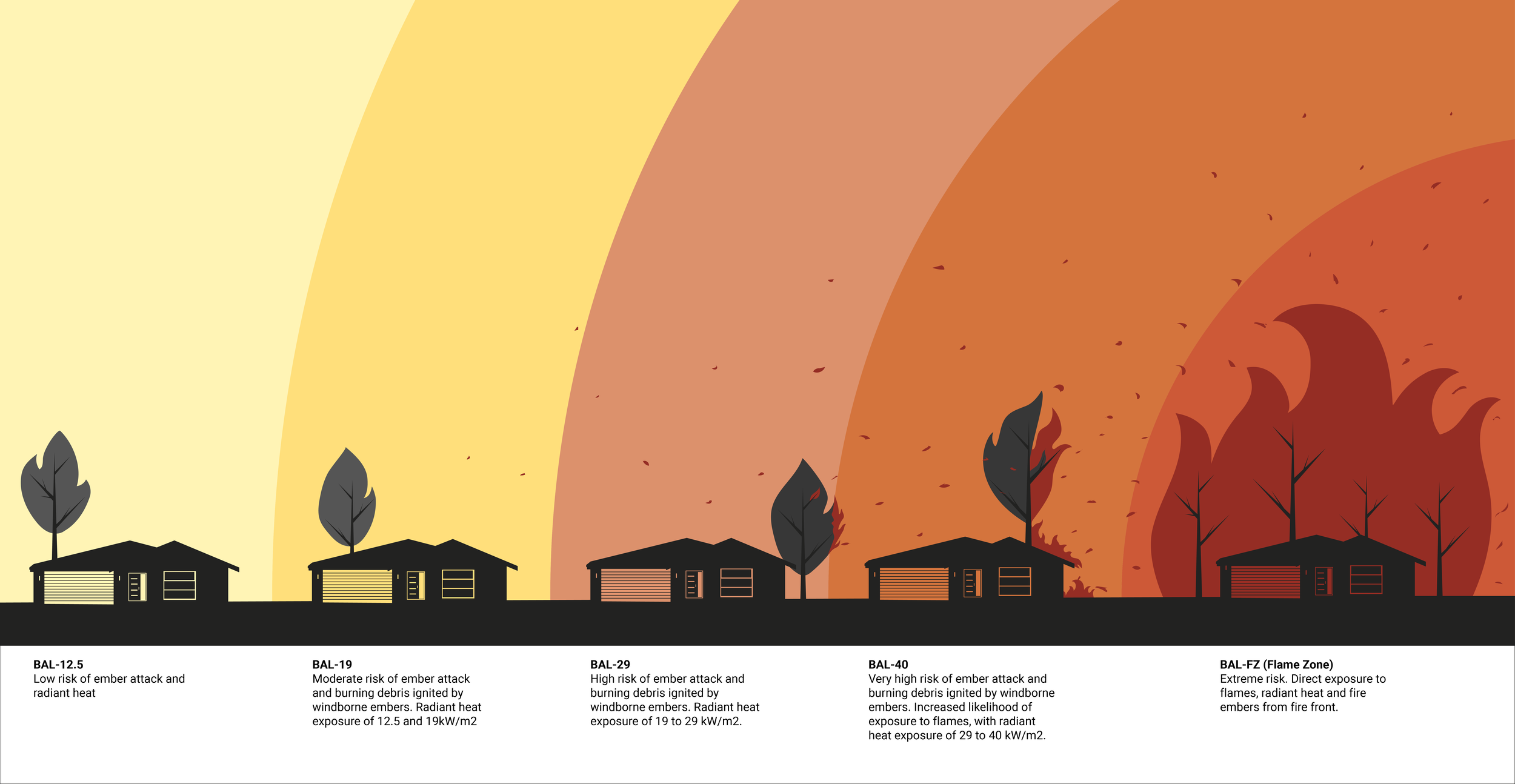What is a Bushfire Attack Level (BAL)?
Houses can catch on fire from embers, radiant heat and direct contact with flames. A Bushfire Attack Level (BAL) assessment is conducted to determine the risk of these threats affecting your home. It is a necessary tool for engineers and builders to adequately protect a house from future fires.
How is a Bushfire Attack Level (BAL) calculated?
There are two methods for calculating a BAL. The simplified approach is suitable for most areas and conditions. Another more detailed method exists but is only used in specific situations that will not be covered in this blog post.
The simplified version consists of five steps:
Step 1: Determining the RFI (Relevant Fire Danger Index)
The RFI is a rating system for potential fires, based on the climate and vegetation of an area. The ratings vary from low-moderate (green) to catastrophic (red) and can change throughout the year. You have probably seen a version of this system on signs next to country roads.
Step 2: Classifying nearby vegetation
The type of vegetation near a house can affect how fast a bushfire spreads. The classifications range from forests and woodlands (lower risk) with sparse foliage to dry, open grassland (higher risk).
Step 3: Classifying distance to vegetation
This step is fairly self-explanatory. The closer vegetation is to the house, the higher the BAL will be. Even if the fire cannot reach the house directly, embers can still set the house alight from greater distances.
Step 4: Determining the effective slopes
Fire gives off radiant heat that travels out and upward. This effect causes a fire to give off a greater heat flux and spread faster when moving uphill compared to downhill. Therefore, the slope of the land below the vegetation needs to be measured and factored into the BAL rating.
Step 5: Determining the Bushfire Attack Level (BAL)
The last step of the assessment is determining the BAL. The information from the previous steps is collated and used to find the BAL via tables provided in AS3959. This rating is then passed onto the engineer and builder to incorporate preventative measures into the design of the house.
What are the 6 Bushfire Attack Levels?
There are 6 BAL categories, which are defined by the expected radiant heat. Radiant heat is measured in kW/m2.
The 6 BALs are:
BAL-LOW (insufficient risk for additional preventative measures)
BAL-12.5 (0-12.5 kW/m2)
BAL-19 (12.5-19 kW/m2)
BAL-29 (19-29 kW/m2)
BAL-40 (29-40 kW/m2)
BAL-FZ (40+ kW/m2)
Protective measures are then assessed based on the rating (with the exception of BAL-LOW).
AS3959 also gives some examples of phenomena experienced at different levels of radiant heat. To give you a better idea, humans feel pain after 3 seconds at 10 kW/m2. Whereas timber can be ignited once the radiant heat reaches 25 kW/m2. At 55 kW/m2 or above, timber can ignite within 10 seconds.
How are houses protected from Bushfire Attack?
There are several ways to lower the risk of a house catching on fire. However, they mostly fall into one of the following categories:
Using non-combustible or fire-resistant materials for members such as stumps, bearers and joists.
Using non-corrosive mesh coverings over openings, such as vents and weepholes.
Ensuring the building envelope is adequately sealed.
Ensuring that adjoining structures are constructed with the same preventative measures, or separated by distance or a fire-rated walls.
How you can check your Bushfire Attack Level (BAL):
Fo Victorians: The Victorian State Government has developed a website called Mapshare. It’s an online preliminary test which informs you of what your bushfire attack rating may be. You can simply type in your property address and create a report, which in turn, can identify details of your BAL rating.
Further reading for Bushfire Attack Level (BAL)
The VicPlan ‘Mapshare’ website is an excellent tool to use when trying to identify your bushfire attach level.
What we can do for you
Arbiter Group have extensive experience in all areas of residential structural design, including BAL assessments.
Ring us on 1300 272 483 for a chat with an experienced structural engineer.




